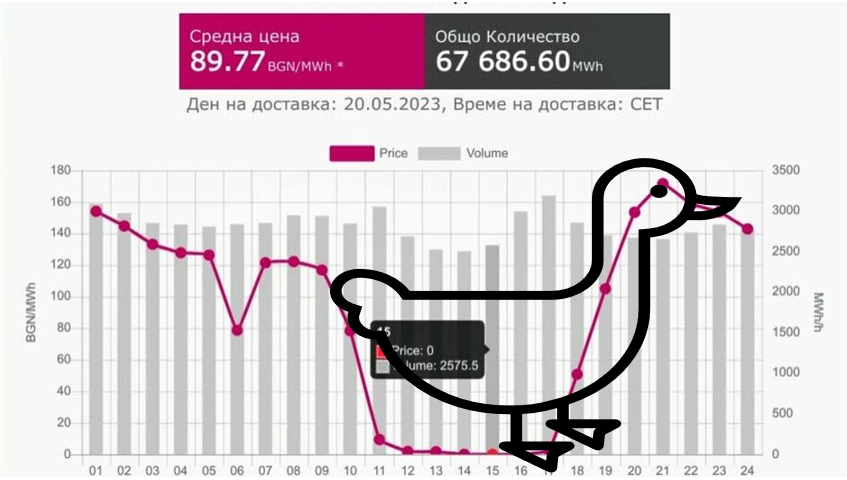How storage adds value to renewable energy assets and what you need to know before you build your business case for co-located assets.
Mariyana Yaneva, APSTE
Bulgaria, Greece and Romania all achieved a GW-market status for solar PV in 2023, meaning more than 1 GW of new photovoltaic (PV) power plants connected to the grid last year in each of the countries. This fast-paced development is bound to significantly impact electricity prices locally and regionally, competitively pushing out fossil fuel generation but also eroding its own business case by flooding the market with cheap energy at noon hours. The business case for electricity storage in battery energy storage systems (BESS) is beginning to emerge, especially for Bulgaria.
With about 1.7 GW of grid-connected capacity in mid-2023, solar power contributed up to 40% of the electricity supply, even if only for a few hours on sunny days. The country closed 2023 with over 3 GW of PV power plants in operation, practically tripling installed capacity in less than two years and achieving its current NECP target about seven years earlier. On top of that, Bulgaria’s TSO is projecting 1 GW to 1.5 GW of new solar to come online in 2024, and the country has not even officially launched its long-awaited tender for 1.7 GW of co-located RES/storage assets yet.
Romania and Greece, on the other hand, have already launched their storage schemes under the Recovery and Resilience Mechanism and the trend toward storage, mostly solar-plus-storage, is gaining momentum on Balkans. The race is on now as to which country will manage to offer a power market design that best captures the value storage adds to a wind or solar asset, in terms of capacity firming, dispatchability and system services to the grid.
If we take the perspective of an investor planning a solar-plus-storage project on the Balkans right now, the task is not easy. Outside the different schemes under the EU’s Recovery and Resilience Mechanism, none of the countries has a clear route to market or an established regulatory framework for storage systems. Nevertheless, a clear business case is emerging in all three countries - addressing the phenomenon known as the “duck curve” of solar power generation.

In power grids with high levels of installed solar capacity, large imbalances can occur between electricity supply and demand that result in a drop in prices (sometimes even in negative territory) during midday hours, when solar generation is high, followed by a sharp increase as the sun sets and solar generation decreases. Battery storage in solar-plus-storage projects can help mitigate the duck curve by storing excess solar energy generated during the day and then discharging it during evening peak-demand periods. If the market design allows it, storage can also bring other revenue streams from providing ancillary services to the grid, such as frequency regulation, voltage control, and capacity services—the ability to maintain energy availability and rapidly respond to load changes, ensuring grid stability and reliability.
Project economics may vary from country to country, depending on permitting time, grid connection process, grid fees and opportunities to stack revenue streams from different markets, but one thing must not be underestimated, and this is understanding the complexity of technological quality assurance and operational logic of the BESS. The sizing of the storage part and the technology choice largely depend on the application (use case) of the system and there are a lot of trade-offs that need to be considered (and modeled) before placing the equipment order. Here are some of them:
|
Key BESS parametres
|
Explanation & trade-offs
|
|
Storage duration
|
Smoothing out intra-day PV variations and the provision of ancillary services requires shorter durations, ranging from 0.5 to 2 hours. Load shifting in utility-scale systems and stacking revenue streams from different markets typically requires four hours of storage.
|
|
C Rating
|
The speed at which a battery is fully charged/discharged, known as C rate of the BESS, will also strongly depend on how the asset will be operated. 1C and higher is typical for ancillary services focused assets while 0.5C and 0.25C are preferred in assets which will mostly shift energy from renewable energy assets.
|
|
Cycles per day
|
How many cycles per day the battery will perform is critical to determine the degradation of battery performance over time.
|
|
Depth of Discharge (DoD)
|
Depth of Discharge refers to the percentage of capacity that has been discharged from the battery relative to the total available capacity. It is perhaps the most important metric that influences how long your batteries will keep powering through.
|
|
Throughput
|
Cyclic aging and the resulting degradation curve for the battery performance is highly influenced by the energy throughput – the total amount of energy that moves through the battery in a specific period.
|
All these technical parameters and the trade-offs between them must be well understood before deciding on the financial model for the asset. Investors also need to ensure that high availability and safety of energy storage systems are well reflected in product warranties and performance guarantees.
The business case for co-located renewable energy and battery storage assets will be a key topic at the 4th edition of RE-Source Southeast, taking place on May 15-16, 2024 at Sofia Tech Park. A dedicated discussion panel will gather experts from Bulgaria, Greece, and Romania to share local market insights and tips for successful investments.

Moreover, the Association for Production, Storage and Trading of Electricity (APSTE), in cooperation with International Power Supply (IPS) will organise a BESS demo tour as part of the event.
The guided tour will demonstrate a life-size battery energy system and look into the details of key technical parameters and operational logic programming, followed by question-and-answer session.
Registration for RE-Source Southeast is already open. The demo tour will require separate pre-registration. Due to limited capacity for the transport, not all registrations for a site visit during RE-Source Southeast will be approved. Nevertheless, APSTE encourages interested parties to register, so a follow-up event could be planned.